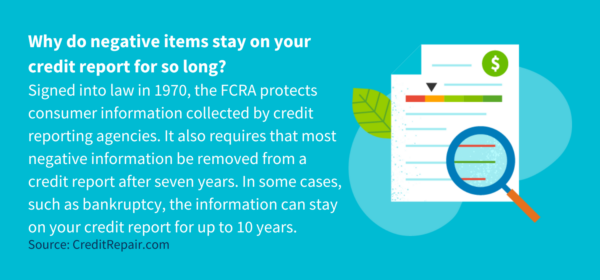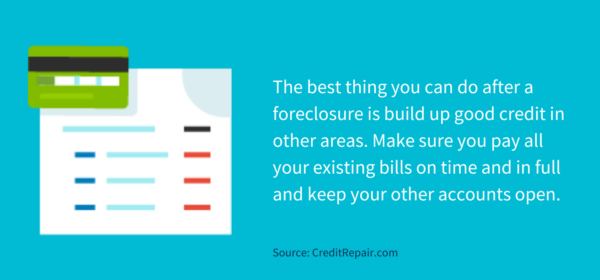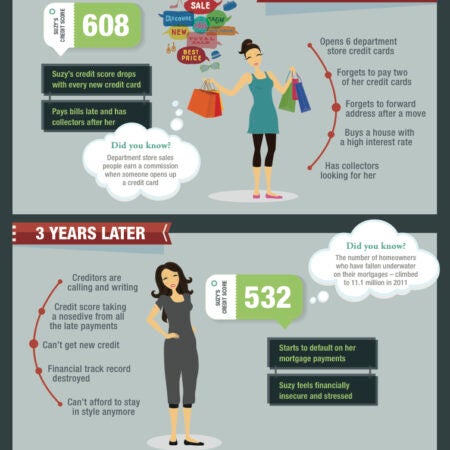
Disclosure regarding our editorial content standards.
You want to avoid having negative items appear on your credit report as much as possible. Not only do these items pull your credit score down, but they can stay on your account for an extended amount of time. But just how long do negative items stay on a credit report? The answer is a bit more complicated than you might think. Generally speaking, most negative items can remain on your credit report for up to seven years. But there are some exceptions—for example, some bankruptcies can stay for 10 years, and hard inquiries can stay for two years.
What are negative items?
A negative item is a line on your credit report that indicates negative or derogatory information about you from a lender. Some examples of negative items include missed payments, collection accounts, repossessions and foreclosures. When a negative item is added to your credit report, it can decrease your credit score. The presence of negative items can act as a warning to future lenders and may cause them to deny your application for credit or give you less-than-favorable loan terms and interest rates.
The good news is that negative information isn’t going to follow you around forever. Negative items stay on your credit report for several years, ranging anywhere from two to 10 years. Typically, the older a negative item is, the less it affects your credit. And after the maximum time has passed, the negative item must be removed from your credit report, thanks to the Fair Credit Reporting Act (FCRA).
It’s important to note that the FCRA doesn’t state how long negative items have to stay, just the maximum amount of time they can stay based on specific factors.
Why do negative items stay on your credit report for so long?

The Fair Credit Reporting Act (FCRA) governs how long negative items stay on your credit report. Signed into law in 1970, the FCRA protects consumer information collected by credit reporting agencies and makes sure everyone has free access to their credit reports. It also requires that most negative information be removed from a credit report after seven years. In some cases, such as bankruptcy, the information can stay on your credit report for up to 10 years.
Hard inquiries: Two years
Every time you apply for new credit or a loan, it’s very likely your prospective lender will pull your credit report. This is known as a “hard inquiry” and gives the lender a complete overview of your credit profile. While it’s not necessarily an adverse action, a hard inquiry can temporarily lower your credit score because it shows you’re trying to access new credit.
Unfortunately, it’s nearly impossible to avoid hard inquiries because you’ll run into them when you get a new car, a mortgage, a personal loan, a credit card and more. Luckily, a hard inquiry can only remain on your credit report for up to two years. Additionally, it will stop impacting your score much within the first six months to a year.
However, if you have multiple hard inquiries in a short period, the damage to your score can be more dramatic. Several hard inquiries can imply that you’re desperate for credit or that borrowers are rejecting you. But, if you want to shop around for options, several hard inquiries might be necessary. Luckily, there is a workaround.
What you can do: First of all, creditors always need to ask permission to conduct a hard inquiry, so you’re in control of who can run a hard credit check on you. Second, let’s say you’re looking to acquire a mortgage or an auto loan and you want to shop around for a few lender options. You can limit the damage of multiple hard inquiries on your credit report by having them all pulled within a 14- to 45-day span. If all the inquiries for the same type of loan are pulled within this time frame, they should only count as one inquiry.
Late or missed payments: Seven years
Whenever you make a late payment or miss a payment entirely, your lender can report the negative information to the credit bureaus. Having this type of negative item on your report can lower your credit score and act as a warning to other lenders that you’re not reliable with payments.
Late and missed payments can stay on your credit report for up to seven years from the date of delinquency. Unpaid accounts show up as 30, 60 and 90 days late (and on) and will continue to have an increasingly negative impact on your credit the longer the bills are left unpaid.
Over time, the impact of a late or missed payment will continue to decline. You can help reduce its impact by establishing a history of on-time payments so that the indiscretion is just a one-time occurrence.
Note that most creditors don’t report a late or missed payment until it’s more than 30 days past due from the original payment due date. This means that if you miss the original due date but manage to pay within 30 days, there’s a possibility your lender won’t report the negative information to the credit bureaus.
What you can do: You can be proactive and reduce the risk of missed or late payments by having as many payments on auto-pay as possible. If you do miss a payment, try to pay it as soon as possible to limit the damage done to your credit.
Charge-offs: Seven years
If you stop paying an account for an extended time, the lender may choose to “charge off” the account. This is when the lender closes the account and reports it to the credit bureaus as unpaid. Charge-offs can stay on your credit report for seven years and 180 days from when the lender reports the negative item to the credit agency.
Unfortunately, a charge-off is a fairly serious negative item to have on your report because it indicates that you simply stopped paying your lender. Charge-offs can lower your credit score and impact your ability to get approved for new credit in the future. As is the case with other negative items, charge-offs will have a lessened impact on your credit as more time passes.
What you can do: If you can afford to do so, try to pay the outstanding debt partially or in whole. Settling the account won’t remove the charge-off from your credit report or reverse the impact on your credit score. However, it’ll reduce the risk that you’ll be sued over the charge-off.
Collection accounts: Seven years
When a lender charges off your account, they may choose to sell the account to a debt collector. A collection account on your credit report is a serious offense that will lower your credit score and make you look like a high-risk borrower to future lenders. And a collection account can stay on your credit report for up to seven years.
What you can do: As is the case with charge-offs, you should consider reaching out to the collection agency to make a payment on the account. Note that you can often negotiate with debt collectors to agree on a slightly lower payment. You’ll need to verify that the collection agency truly owns the debt, and you should get all agreements in writing before you make a payment.
Paying off a collection account won’t remove it from your credit report or reduce the impact on your score, but it can help overall. Future lenders will see that you chose to pay off the account, which can act in your favor.
Student loan delinquency and default: Seven years
Missed and late student loan payments can stay on your credit report for up to seven years. The consequences of missing these payments differ slightly depending on if you have private or federal student loans.
Federal student loans will report negative information to the credit bureaus after 90 days of missed payments. A federal student loan will go into default after 270 days of no payments. The government has a lot of power when it comes to forcing repayment on federal student loans. You can have your wages garnished or your tax refunds and Social Security benefits garnished.
Private student loans can show up as a negative item on your credit report after 30 days of missed payments. Your private student loan can go into default as soon as you miss a payment, but private lenders can’t force repayment easily. Private student lenders will need to take you to court to force payment.
What you can do: As soon as you miss your student loan payments, contact your lender to make things right. If you’re finding yourself behind on payments, you may ask if you can be set up on a different type of payment plan (income-driven, modified payment plan, etc.). And if your loan is already in default, you’ll have to work with your lender to rectify the situation. For example, federal student loans allow for three options when in default: repayment, consolidation or rehabilitation.
Foreclosures and repossessions: Seven years
If you continue to miss payments on your property, your lender may “foreclose” and take the home back. A foreclosure can stay on your credit report for up to seven years from the date of the first missed payment. Foreclosures impact your overall credit score and future eligibility for credit.

What you can do: The best thing you can do after a foreclosure is build up good credit in other areas. Make sure you pay all your existing bills on time and in full and keep your other accounts open.
Closed accounts: Seven to 10 years
A closed account can remain on your report for up to 10 years, depending on its status at the time of cancellation. An account in good standing will stay on the report for a full 10 years, serving as a positive contribution to your credit. If the account wasn’t in good standing, it won’t be removed for seven years.
However, closing an account, no matter its status, may temporarily lower your score. Any negative information associated with a closed account, such as late payments or referral to a debt collector, can linger on your credit report for seven years. If the account was in good standing, closing it may increase your credit utilization, or how much of your total available credit is currently in use. A higher utilization typically means a lower credit score.
Length of credit history and credit mix should also be considered. If the closed account was one of your oldest credit cards, several years of credit history showing you as a responsible borrower may now be gone. Lenders also prefer to see a mix of revolving and installment credit, such as credit cards and loans. Closing one type could potentially decrease your score.
What you can do: Be thoughtful when choosing an account to close. For example, if you’re worried one credit card is encouraging you to overspend or costing too much in interest, closing it could lead to better long-term outcomes.
Bankruptcies: Seven to 10 years
A personal bankruptcy is a legal filing where individuals seek relief from their debts because they can no longer pay them off. There are two main types of bankruptcies: Chapter 7 and Chapter 13. A Chapter 13 bankruptcy can stay on your credit report for up to seven years. Conversely, a Chapter 7 bankruptcy can remain on your account for up to 10 years from the filing date.
A bankruptcy is one of the most harmful negative items to your credit score and can reduce your score significantly.
What you can do: It can be challenging to recover from bankruptcy as many lenders won’t want to extend credit to you. Still, you must focus on rebuilding your credit as soon as possible. Some options include signing up for a secured credit card or a credit builder loan. Make sure to be responsible with your credit moving forward, and never take on more than you can afford.
You can improve your credit even when you have negative items
If you have negative items on your credit reports, don’t worry—they aren’t permanent. You can work to slowly improve your credit and offset the effects of negative items by making payments on time and in full, lowering your credit utilization ratio and paying down debts.
You should also always check your credit reports. If you see any negative items that are unfair, inaccurate or unsubstantiated, you can dispute them with the proper credit bureau and potentially get them removed sooner than if you waited for them to drop off on their own.
If credit repair feels overwhelming to you, there are professional credit repair services available that can help you. CreditRepair.com helps by evaluating your credit reports, disputing items on your behalf and educating you on healthy credit habits. Find out how we could help you today.
Note: The information provided on CreditRepair.com does not, and is not intended to, act as legal, financial or credit advice; instead, it is for general informational purposes only.
Questions about credit repair?
Chat with an expert: 1-800-255-0263






